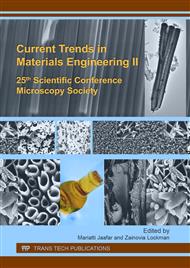p.206
p.211
p.215
p.220
p.224
p.228
p.232
p.236
p.240
Processibility and Thermo-Mechanical Properties of Epoxy as Reactive Plasticizer of Polyetherimide
Abstract:
A relatively new way to improve processibility thermoplastics is via the use of crosslinkable monomers which can act as reactive plasticizers and reduce the viscosity in the early stage of processing. The monomers can polymerize and phase separate during final stage of processing thus recovering the original thermoplastics properties. In this work, the applicability of epoxy as reactive plasticizer for polyetherimide (PEI) was investigated. The properties of PEI/epoxy blends without and with curative were studied in order to determine the effect of the monomer on the processibility of the PEI and the thermo-mechanical properties of cured blends. Differential Scanning Calorimetry on blends without curative indicated single glass transition temperature (Tg) at high PEI content suggesting miscibility of the system and plasticization of PEI in the presence of epoxy while cured blends indicated two Tg due to phase separation. Scanning electron microscopy of the cured blends indicated two phase morphology with PEI dispersed particles size increased in continuous epoxy matrix with increasing PEI (up to 30wt% PEI). In blends with 40wt% PEI and more, phase inverted morphology was observed where increasing PEI content caused reduction of epoxy particle size in continuous PEI matrix.
Info:
Periodical:
Pages:
228-231
Citation:
Online since:
September 2017
Keywords:
Price:
Сopyright:
© 2017 Trans Tech Publications Ltd. All Rights Reserved
Share:
Citation:


